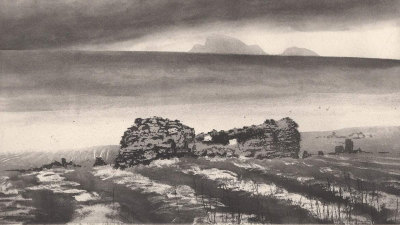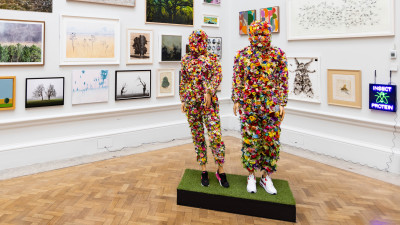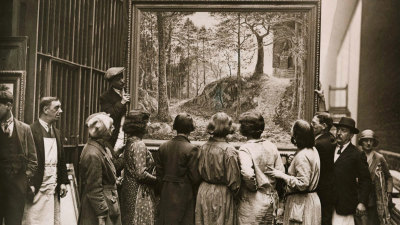Summer Exhibition Edit: Will Gompertz
Summer Exhibition Edit: Will Gompertz
By Will Gompertz
Published 12 August 2014
We’ve challenged three guest speakers to choose the five works in this year’s Summer Exhibition that intrigue them the most. BBC’s Arts Editor Will Gompertz attempts to narrow down his top picks from the plethora of works on display.
-
Listen to a full audio recording of this tour.
-
Yinka Shonibare RA (Wohl Central Hall, Work 12)
“He’s suggesting a tipping point. Everything’s just about to fall over: the man’s about to topple over, the cake’s about to fall over. I suspect this is a time in the economic cycle when the West and Africa are going to collapse. Personally, I think it’s a bit heavy-handed.”
-

Wohl Central Hall, Summer Exhibition 2014
Showing works by (L-R) Bob and Roberta Smith RA, Yinka Shonibare RA, Rosemarie Trockel Hon RA and Conrad Shawcross RA.
Photo: Benedict Johnson
-
Marlene Dumas (Wohl Central Hall, Works 6 and 7)
“These are two of the finest works in this exhibition. She is, as you can see, a Modernist – in the way she abstracts details and information from the image to get to the purity of the emotion she’s trying to convey. They’re uncomfortable to look at and they’re uncomfortable to be with but they have a power. I always think any artist who can transmit the power of human feeling just through the stroke of a brush is truly remarkable. And in Marlene Dumas I think we have one of the world’s finest artists.”
-

Marlene Dumas Hon RA, Helena.
Oil. 60 x 50 cm.
-
Rowan Fuggle (Lecture Room, Work 1219)
“The work I want to draw your attention to is tiny. It’s by a young artist who’s just left the Ruskin School in Oxford. It’s a pencil drawing and it’s absolutely exquisite. I think there is a new trend in art, we’ve seen it in the Turner Prize – for detail, for craft, for drawing, where people are really paying attention.”
-
Wolfgang Tillmans (Gallery IX, Work 1175)
“For me, he’s one of the most important artists working in the contemporary canon – certainly one of the most thoughtful. It’s a piece of colour-field art, a piece of Abstract Expressionism. He’s not in competition with his colleagues of the 1950s, he’s just trying to push the medium of photo-imaging as far as it can possibly go in the modern world. He’s interested in the fact that this piece of art couldn’t have been created 10 or 15 years ago, it could only have been created today. It’s a hugely sensuous piece of art, a beautiful object to look at.”
-

Wolfgang Tillmans RA, Greifbar 1.
Inkjet print. 250 x 370 cm. Photo: John Bodkin, DawkinsColour.
-
Georg Baselitz (Gallery III, Work 33)
“This is unusual for Baselitz. You might know him for doing really thick, impasto paintings of people, who are always upside-down. They’re done in a typical German Expressionistic way. But this is much more gentle. This feels very expressive, but much more peaceful than his normal work.”
-

Georg Baselitz Hon RA, In London Schritt für Schritt (In London step by step).
Oil. 304 x 184 cm. Photo Jochen Littkemann, Berlin.
-
Anselm Kiefer (Gallery III, Work 20)
“This is the work I’d take home, if I had the wall space for it. It’s called Kranke Kunst, which means ‘sick art’. It is a reference back to ‘degenerate art’. It reminds us all of what it must be like to be a German artist, in the generation of Kiefer and Baselitz, dealing with the war, and what it is to be a German. I think this is one of the best works made in recent time. It’s epic both in scale and in topic.”
-

Anselm Kiefer Hon RA, Kranke Kunst.
Mixed media. 280 x 380 cm.
-
Una Stubbs (Small Weston Room, Works 673 and 674)
“I picked these two works out because I thought they were fun. It’s easy with art to take it far too seriously, but art is just a communication between human beings.”
-

Una Stubbs, Martin.
Watercolour. 15 x 10 cm.
-
Summer Exhibition 2014 is at the RA until 17 August 2014.
Summer Exhibition is sponsored by Insight Investment











